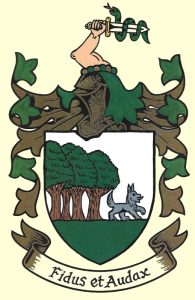 The use of coats of arms to identify noble knights arose in the late Middle Ages. Usually some distinctive geometric pattern or animal figure was painted on a shield. Its usage was reserved to a certain person or his descendants.
The use of coats of arms to identify noble knights arose in the late Middle Ages. Usually some distinctive geometric pattern or animal figure was painted on a shield. Its usage was reserved to a certain person or his descendants.
The earliest evidence of the O’Callaghan coat of arms dates from the 18th century. In 1723 the Royal Herald James Terry, at the request of Mathew O’Callaghan, a captain in the Spanish service, described the family coat of arms in these words: “on a silver shield issuing on the left from a green wood, a wolf, in its own colors.” A year later the Gaelic poet, Aodhagán Ó Rathaille (Egan O’Rahilly (d 1726) spoke of “a wolf, fierce, violent, impetuous/ Issuing from the wood’s border in rapid race/ And going forth to hunt in the plains of Fodla.”
The coat of arms was depicted for the first time around 1740 at the foot of a portrait of the distinguished attorney Cornelius O’Callaghan. A wolf emerges from a wood while at the top of the shield a flexed arm holds a sword around which a snake is entwined. An identical inscription engraved on a monument erected by his cousin, another Cornelius O’Callaghan, Sr. (d. 1739), in Clonmeen church. The monument which is no longer visible in the ruins of the church also recorded the first evidence of the family motto Fidus et Audax – Faithful and Courageous or Faithful and Bold.
